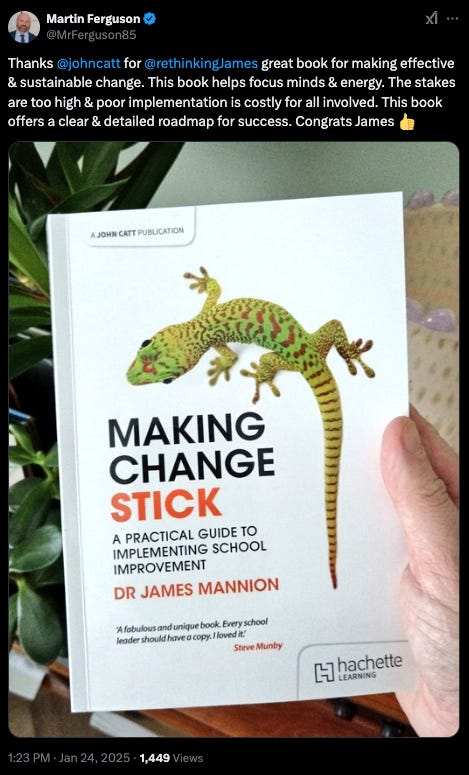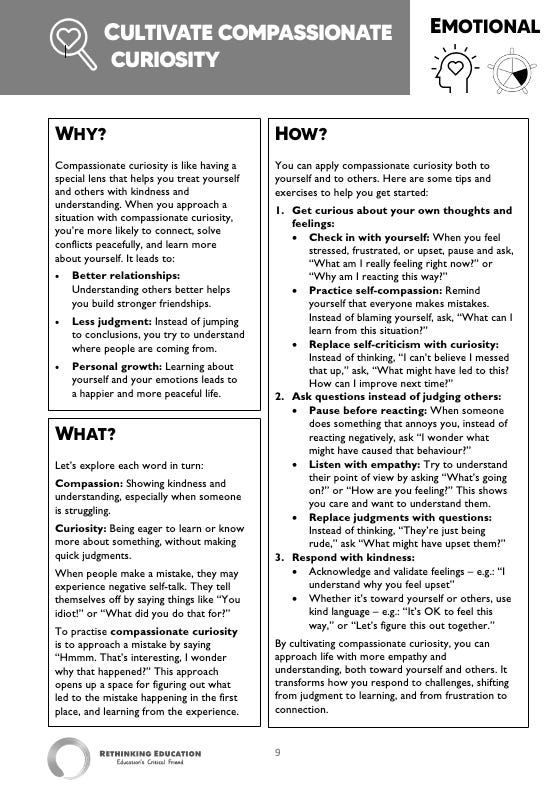How to get better at learning stuff
Part two of two on the (endlessly fascinating) topic of learner effectiveness
Before we dive in, I hope you will indulge me in sharing two upcoming things:
1. My book totally came out yesterday!
People are posting photos of it on social media and it feels REALLY WEIRD. It’s available in all good bookstores - some of them even pay their taxes, or so I’m told.
The good news for you is that this is the last time I’ll be hawking my book launch. If you’re reading this in the newsletter that goes out on a Saturday morning - IT’S TODAY!!! 11am-12pm UK time. Do join me if you can - I’d love to see your beautiful face!
After a light grilling by the wonderful Rachel Macfarlane, there will be some *amazing* prize giveaways, including:
5x signed copies of the book
1x 1h implementation coaching session for your school (worth £100)
1x 3-year membership for your school/organisation (worth up to £3,950)
Don’t worry if you can’t make it live, I’ll send a recording afterwards. But to be in with a chance of winning, you need to a) share the post on social media (shameless, I know) and b) sign up. here are some social media sharing links:
Hope to see you at 11!
2. Tina Farr is spreading joy and belonging
One of the many amazing people I’ve met through this Rethinking Education malarky is Tina Farr, the headteacher of St Ebbe’s Primary School in Oxford (and our next guest on the Rethinking Ed podcast, alongside Debra Kidd).
Tina has recently started running workshops as a way to raise funds for her school, and so although this is a paid thing, I feel intensely relaxed about sharing it because a) Tina is amazing, b) it’s for a worthy cause and c) it’s about spreading JOY for goodness’ sake.
As Tina writes:
Working in education should be the most joyful, fulfilling profession and yet talented staff have been leaving our brilliant profession in droves over the past few years. It’s time for school leaders to deeply consider the root causes of the recruitment and retention crisis and to revisit the purpose of education and its effect on the culture of our schools. In just two hours, this online training supports a shift from acceptance of the fear that permeates our schools, to a sense that schools can once again be joyful places to work.
From fear to joy… I mean, what’s not to like???
Tina ran this workshop back in November and the feedback was sensational. The next one is on Monday 3rd Feb, 3.30-5.30pm UK time. Hit the button for more deets:
OK, let’s do this!
How to get better at learning stuff
In my last post I introduced the ‘ship’s wheel’, a model for thinking about learner effectiveness as a multidimensional construct:
I received some *super interesting* and encouraging feedback about this model this week, both in the comments and via email. I’d love to dig into this in a future post and respond to some of the points people have made.
In this post, I’d like to explain how we can use the ship’s wheel model to identify where children and young people’s barriers to learning lie, and how to identify improvement strategies to help them move forward in each of these domains. This should be of interest to parents and, well any human being to be fair, so it’s not just a teacher thing.
And as with my last post, I’m really keen to hear what you think of this, reader.
The rationale
As I mentioned in my last post, one big reason for thinking hard about this ship’s wheel idea is that schools are often overly focused on the cognitive domain - understandably, given the high stakes accountability around exam results. And of course we want people to learn and remember stuff and gain qualifications and so on.
But if children and young people are underdeveloped or struggling in the other domains, they’re going to struggle in the cognitive domain also. So we really need to figure out get out of the red wedge and help kids develop in a more holistic way.
The challenge
Part of the problem in doing this is that a) kids are all different, and b) as we’ve established, learner effectiveness is multidimensional. So how can we provide each of them with the support they need?
The solution
Broadly speaking, I think we need two things:
A cyclical curriculum, where we visit each of the six domains of the wheel regularly so that each kid regularly reflects on their strengths and areas for development in each of these domains.
Diagnostic tools that allow teachers and students to identify:
areas for development, and
strategies to help them move forward in different domains.
Root cause analysis
I’ve been working a lot with Root Cause Analysis (RCA) recently - there’s a chapter on it in my new book.
One neat RCA tool is the problem tree. The idea explains itself really. The core problem that you want to solve is the trunk. The branches are the consequences. And the roots are… well, the root causes.
Let’s say Child A doesn’t read for pleasure. They just don’t buy into that whole ‘feed your mind’ thing. Their problem tree might look something like the following:
As you can see here, we can use the 6 domains of the ship’s wheel model to analyse the root causes. With regard to not reading for pleasure, Child A’s root causes might be some combination of the following:
Physical: Tired, short of time (e.g. long commute, lots of enrichment activities, they are a carer), nowhere quiet to read, unsupervised access to devices.
Emotional: Don’t like reading, makes them ‘feel stupid’, they have never really connected with a book / author / story. They say they ‘hate reading’.
Behavioural: Often misplace their books, no regular time for reading, other things (eg tech, spending time with friends) seem more engaging.
Relational: Self-perception – ‘I’m not a reader’. Reading has not been modelled to them. Nobody to talk to about reading, or to read with.
Cognitive: Lack understanding of why reading is important, how to read effectively, how to read by themselves. Lack reading strategies – e.g. how to skim, how to approach unfamiliar words.
Navigational: Aware that they should read more, but unaware of strategies to help them get from where they are to where they want to be.
The idea is that you’d go through this process with the child, to help them identify where the roots of their reluctance to read might lie. (After all, the ultimate aim of the ship’s wheel is for the child to learn how to stand ‘at the helm’ and take control of their own lives and learning).
Depending on what you notice, you might identify a range of potential strategies to help them move forward in the relevant domain. For example:
Physical: Address tiredness (e.g. sleep, nutrition), listen to audiobooks on commute, find quiet/comfortable spaces to read, provide access to engaging books, library membership etc.
Emotional: Start small, offer specific praise/encouragement, involve the child in choosing a highly-rated page-turner that they want to read.
Behavioural: Develop habits of self-organisation – where to put things, having a checklist, setting an alarm, setting aside time to read, managing distractions e.g. tech
Relational: Model reading, find role models, reading mentors, start a book club, share books with friends / family, find books recommended by existing role models.
Cognitive: Share reading strategies, talk about how reading affects productivity and success (successful people tend to read a lot), and that it helps you understand yourself and the wider world.
Navigational: Explore improvement strategies such as backward design, root cause analysis, goal setting, weekly reviews, implementation intentions, PDSA cycles, and steps to success.
I’ve recently been working on a *super exciting* project where we’ve created one-page strategies to help people develop in these domains. For example, here are some strategies that might help Child A move forward with this ‘feeding your mind’ thing:
Physical:
Emotional:
Behavioural:
And so on.
It’s a bit of a work in progress at the moment, but we’re planning to roll these resources out in schools over the next few years.
We’ve created 36 strategy cards so far - six in each domain - and more are coming down the track. There’s also a 2-year professional learning programme for teachers, leaders and support staff, and some lesson resources.
The most obvious place for these resources to be used is in PSHE / health and wellbeing / tutor time and so on. But ideally this thinking should be integrated with what’s happening in subject teaching. I’m not sure how we’re going to square that circle yet, but we have some ideas.
It’s early days, but I really think this idea has legs. But then I would, wouldn’t I… Kate and I have invested a *crazy* amount of time thinking and talking about this and creating resources and whatnot.
So I’m really interested to hear what you think.
Please feel free to comment below - or drop me a line by way of reply (or at drjamesmannion.com/contact if you’re not a newsletter person).
In my next post I plan to share something SUPER EXCITING that I’ve been working on below radar with an amazing ‘slice team’ for the last 18 months or so…








